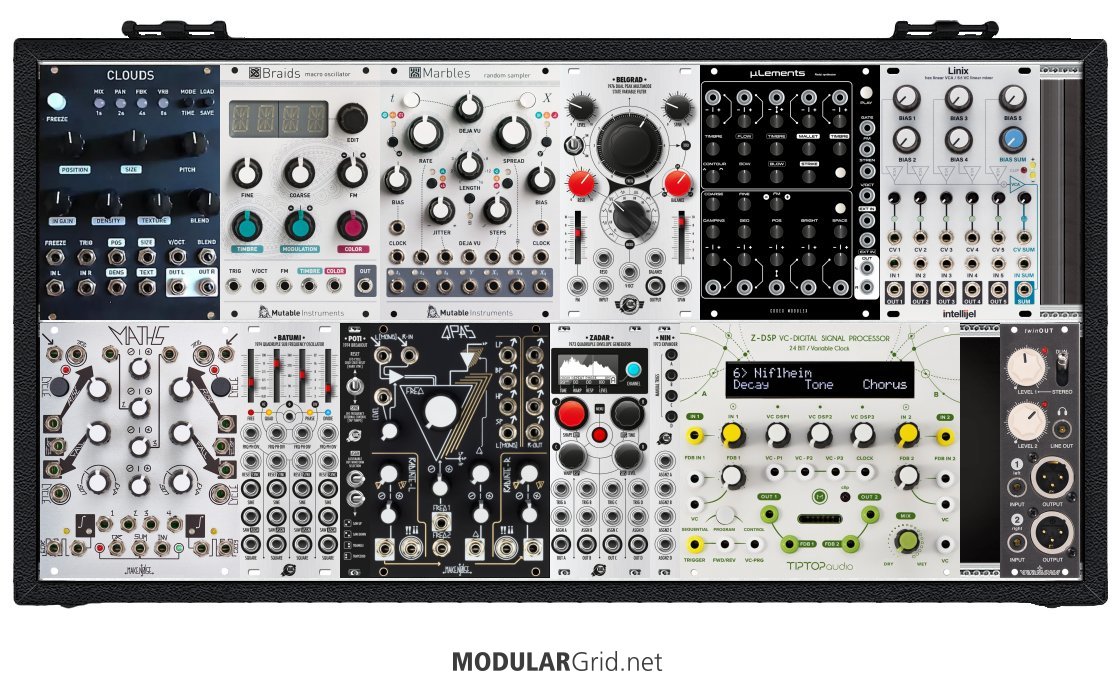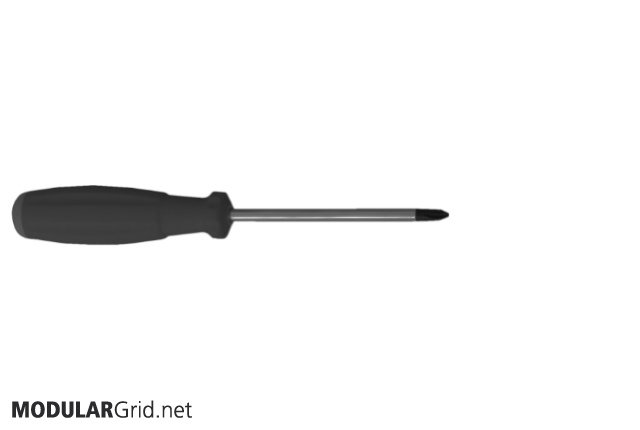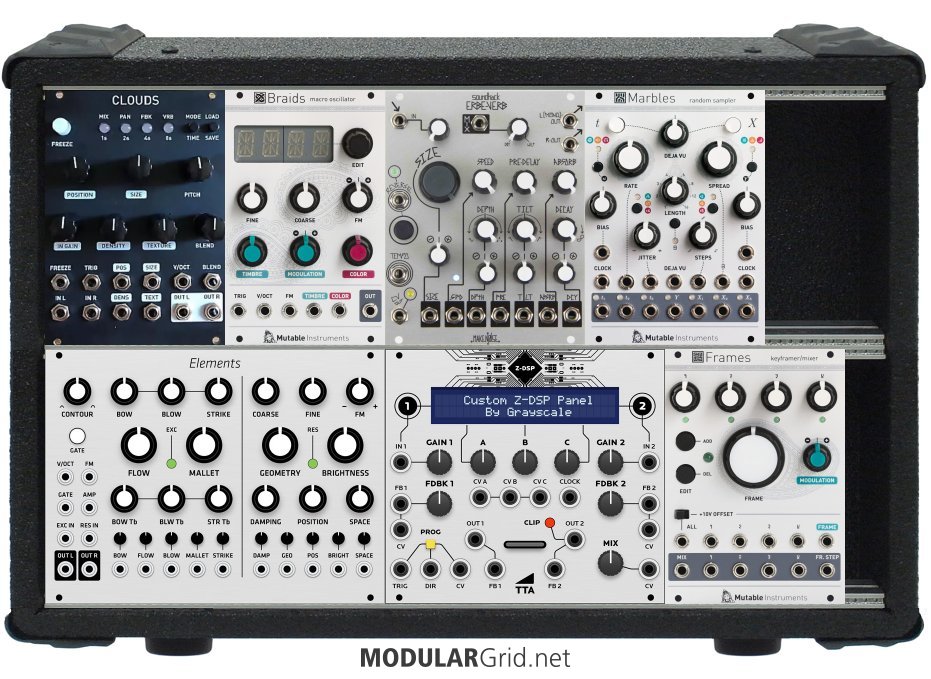I bought a module from @memoire-de-futur. Smooth process. Module in great condition. Recommended.
I bought a module from @memoire-de-futur. Smooth process. Module in great condition. Recommended.
Not sure if you still need a reply, but I have a Morpheus installed in that exact spot in my KB37. It fits just fine.
The entire FORUMS.
When sorting by the latest post, the results aren't so. I'm expecting to see the thread with the newest post at the top, followed by the second newest, third, etc. It seems almost random. Is it being sorted by the latest VIEWED rather than posted? It should be fixed right away as new forum messages and replies are getting buried by older posts.
The above build with all of the Renes doesn't strike me as a very well-considered idea. I see no VCAs, for starters, and a lot of the other necessary items are totally missing.
If you want this many sequencers, you either need a MUCH bigger cab, or you should just chuck the idea of using sequencers in the synth altogether and get something that's a dedicated sequencer device, such as a KOMA Komplex. Occupying this much room with Renes...especially with what's NOT here...seems like a recipe for an expensive and unusable disaster.
-- Lugia
sorry, there is a glitch with that image, dunno why all of the Renes... didnt notice too that when i make some changes,the pic changes... anyway,
here is the last testing of my module :

Go back to the top page of the Forum and you'll see links for the moderators at the bottom. Click on modulargrid's link then send him a PM via the boxed link you'll see at the top of his user page.
The above build with all of the Renes doesn't strike me as a very well-considered idea. I see no VCAs, for starters, and a lot of the other necessary items are totally missing.
If you want this many sequencers, you either need a MUCH bigger cab, or you should just chuck the idea of using sequencers in the synth altogether and get something that's a dedicated sequencer device, such as a KOMA Komplex. Occupying this much room with Renes...especially with what's NOT here...seems like a recipe for an expensive and unusable disaster.
I’m assuming that he modules remaining constant are the ones you have?
Adding Rene and Batumi is great, but you need a clock for Rene to work (Tempi or Pamela’s New Workout would do). A filter is great, but look also at QPAS or a state variable filter. You’ll also need an envelope module (Malekko Quad Envelope or XAOC Zadar) and at least one power module. Consider an Intellijel 7U case with Intellijel 1U modules, as you’ll want an audio I/O and some attenuverters.
-- liquid_air
maths can be the clock of Rene?
This module uses a Jumper to control 5V rail power, so it either draws 100/60/150 or 250/60/0 (according to latest manual for the latest firmware). Possible to add another variation for 100/60/150 (current module shows 250/60/0 - which wasn't the default on the module I purchased)? The 150 mAmps difference on the +12v rail can make a huge difference when trying to add this module to a power constrained setup. Thanks.
I’m assuming that he modules remaining constant are the ones you have?
Adding Rene and Batumi is great, but you need a clock for Rene to work (Tempi or Pamela’s New Workout would do). A filter is great, but look also at QPAS or a state variable filter. You’ll also need an envelope module (Malekko Quad Envelope or XAOC Zadar) and at least one power module. Consider an Intellijel 7U case with Intellijel 1U modules, as you’ll want an audio I/O and some attenuverters.
I had a great transaction with @yrn1, perfect communication and modules in great shape! Thanks!
I recently contemplated a layout of a “portable” sub-rack and settled on an Intellijel 7U case, such as you did. I had a few design iterations with some Muffwiggler FB group input and some trying out. Turns out: I didn’t think the Mimetic Digitalis is well suited to controlling categorical CV (say the b/s/l on a Manis), so I needed a bit more immediate control.
I found that I took a liking to using my modular to complement a sampler (drums, percussion) with harsher basslines and additional percussion. I also quite like the sonic possibilities of combining the Ataraxic Iteritas with a uPlaits for LPF bass, especially using a sequenced mix via Plancks (uFrames) for more timbral control.
So, the underlying design concept was: Manis for percussion, Ataraxic+Beehive for bass. I wanted CV control and sequencing ability for both feeds independently, delay and reverb are essential to the sound I am after. Some distortion would be nice, too.
In this setup you see Manis, MLSC, Verb Form a percussion chain. I opted for two Quadratt 1U as sub-mixers and that works great.
One audio stream will be a side chain feed for the MLSC compressor and a second a utility reverb via the verb.
Plancks will blend Beehive, Ataraxic, and a delay-reverb using the Black Hole DSP2 and Erbeverb chain under full CV control (reverb solo and delay solo can be mixed in via the second Quadratt).
The Voltage block will allow extensive control over the mix (Plancks), Delay (Black Hole), and reverb (Erbeverb).
Pam’s offers up to 8 LFOs (I’m a sucker for those) and Rene two direct control gate/CV channels for Manis and Beehive/Ataraxic. Manis has its own Envelope, and Tallin offers two VCAs with distortion for Hive and Ataraxic. A quad envelope can control both VCAs and still offer two envelopes for filter control. I opted for the Morgasmatron as a SVF with pleasant distortion (I love how this filter clips and the built in Rat distortion is neat as well) and Three Sisters owing to sonic capabilities and HP demand (vs QPAS). Tempi has the immediacy of well laid out performance features, which allows for on the fly clock division changes controlling the Quad Env and Voltage Block. Ornament & Crime combined with an ARP module just round it out nicely.
Thoughts?
I know I’m missing a logic module and really pondered swapping the o_C with a WMD Triple Bipolar, but feel that I should be able to do-opt one Quadratt for CV duty.
Hello,
Currently the manufacturer Warm Star Electronics (http://www.warmstarelectronics.com/) is listed under 'Other/unknown' on the Module Finder. I looked, but couldn't find a way to send this information directly to an admin, but if someone could help me out that would be great.
Thank You
Looks tasty. Though, with that little space you'd be better off loosing the (great) Akemie's for a couple more narrow osc/vcf and utilities. Doing that would give you a more useful rack, IMHO.
thanks! im going to use my idea of the new setup in that software,maybe it Works.
My idea to complete the stuff i posted is something like this...

Actually, the Zadar is a really good idea as a companion for the Akemie's Castle! Coupling that with the Pams and the Varigate could yield some really interesting FM results...nice!
Here is a follow-up and my current thinking:
What I have so far:
1u row except for the Zeroscope, BIA, Ripples, Maths, Quad VCA, Pamela's New Workout, Akemie's Castle, Atlantis and a Beatstep Pro. The Zadar is pre-ordered.
Modules were bought in stages and in my first pass I used Ableton to sequence thru the uMIDI. That was great for getting up to speed, but after considering the 3 primary sound sources, I decided to hold off on sequencing in the case and picked up a BSP, which works great and is close enough to being a physical experience rather than a computer driven one since there is no mouse tempting me to tweak something minuscule in the sequencing.
For the time being, I am mostly running only two things at a time (e.g., a BIA/Atlantis duet or a Akemie/Atlantis duet) with each taking an out channel in the case. The two channels go into an audio interface into two tracks in Live for effects, mostly delay and reverb. Live can also supply the drum machine or other accompaniment.
The goal is still to have the option to move entirely out of the computer for playing. I am probably going to go the route of an external mixer and per this thread I posted:
https://www.modulargrid.net/e/forum/posts/index/3696
(As an aside, there is a great link there to a Muff Wiggler forum thread on the technical details about the audio levels...)
I am going to look at something with lots of headroom and see if it can handle the signal strength of the modular. If not, I'll probably follow Lugia's advice in that thread and look into supplementing the Intellijel case's outs with Ladik P-530s. If that is needed, it would likely take up some/all of the space of the Varigate 4+ in this latest iteration.
I am grateful for all the advice here, but a few points that I have acted on are Lugia's note that the Akemie's Castle will eat up modulation and envelopes and Ronin's comments about letting the case tell you what it wants next (in so many words). Since I was compelled to get my hands on the tactile FM that is AC, but also mindful of these comments, I got the Pamela. It's is a great source of timed modulation in a relatively small space and I can't wait for the Zadar to show up.
Thanks for all the feedback so far and keep them coming if you have any comments about the current iteration.
So I frequently use modulargrid on my phone
What kind of phone are you using?
Oooh, idea: mobile app?
There will be no dedicated native mobile app. I try to make sure that MG runs in most mobile browsers, therefore your bug report is greatly appreciated.
-- modulargrid
I use a lite app shell called Hermit for this (and many other sites) it works really well and allows you to have a couple sites as lite apps before you have to purchase a license.
Getting your hands on free gear is awesome. But you're going to need to add a lot more things to make them useful. My first thought is that you should get a better understanding of how basic modular modules work. There's a free eurorack simulator known as VCV rack. There's a virtual version of Clouds and Braids in it. You will also find a lot of other modules like VCAs, envelope generators, etc.
Learn how to build a basic set-up in VCV first. It costs nothing so you can make as many mistakes as you like and experiment recklessly. Get a good understanding of how it works and you'll find that making decisions on which pieces of kit to add to be a lot less daunting.
traded a Magneto with @tomlaan - perfect condition, great module, highly recommended seller, trader.
traded an Erbe Verbe with @zvuku, all went smooth and module arrived in good condition! thanks!
hi there! im gonna start this adventure and have some modules i received for free, so i would like some advices to complete it.
Will make ambient stuff, and here is what i have for know.
Maybe i need to add MATHS? people says that is a must, but for the moment i dont know anything about it.
Maybe elements?
Any mixer or vca?
let me know please! thanks a lot.

Bought MI Marbles from @yari. Everything was ok. The item was exactly as he described, communication and delivery were also satisfying. Thanks! :)
I am not sure what's going on, I never heard of this problems. But I agree there should be a simple option to set the location, so this feature will come.
-- modulargrid
Thanks, this feature will make spending my hard earned money on modules much easier again.
I still get all the module shops / offers in the "Buy Online"-bar from Canada, US and Japan despite being in EU.
Tried wiping the browser cookies and cache clean, switching the currency to € and listing the offers only from EU and cross-checking with another browser and in private mode, but this behaviour persists. My VPN is set to EU as well so it shouldn't mess with geolocation if there's such. Also tried completely turning off VPN to see if it affects the functionality.
Is there a setting somewhere or is this a bug am seeing here?
-- pkkkkknn
I am not sure what's going on, I never heard of this problems. But I agree there should be a simple option to set the location, so this feature will come.
Beep, Bopp, Bleep: info@modulargrid.net
Disting F6 parameters
Octavian
M32 parameters
Octavian
Overview
Octavian
bought a Midi to Clock V2 from @Slocap ... all good. arrived in good condition and good communication with seller. thanks!
I still get all the module shops / offers in the "Buy Online"-bar from Canada, US and Japan despite being in EU.
Tried wiping the browser cookies and cache clean, switching the currency to € and listing the offers only from EU and cross-checking with another browser and in private mode, but this behaviour persists. My VPN is set to EU as well so it shouldn't mess with geolocation if there's such. Also tried completely turning off VPN to see if it affects the functionality.
Is there a setting somewhere or is this a bug am seeing here?
Ableton: Many Firsts
Octavian
Colour Scheme
Rings
Yellow
Disting
Red
BIA
Blue
Tempi
Green
Ears/Blofeld
Black
Octavian
Overview
Disting - Used C4 (Clockable Ping Pong (Z Input Pan)) algo instead of B4 and sent only delayed signal out of A and B
Routing - Sent Dry and Delayed signals of both ODD and EVEN Outputs on Rings, for a total of 6 tracks recorded at once (Blofeld Dry, Rings ODD Dry, Rings EVEN Dry, Rings ODD Delayed, Rings EVEN Delayed, and BIA)
Rings - Used Modal Resonator instead of Sympathetic Strings, which didn't turn out terribly interestingly
Ears - Sent GATE Into Mod Input instead of State Select Input, sent ENV into Rings Position & Damping as well as BIA Fold, sent audio OUT into M32 Buff Mult to free up space on ADDAC200B for Rings copies
Tempi - Modded Channels 1, 2, and 3 of State #1 and kept it on State #1 as opposed to last Home Improvement patch
Blofeld - Used B043 Marimboid with a bit of Sustain on the Amp ENV so it was a cross between a percussion and a bowed sound
Octavian
Tyme Sefari? Makes sense...it can do that grit-fi sound, and even give you stereo with the Sound of Thunder expander, which is optimized for circuit-bent noisemaking.
What's the impedance of the preamp input? I found nothing on the webpage and in the manual.
I have recently dealt with these sellers and I have nothing but good things to say :
@bernardini
@rsillsley
@minimalmike
@enn_n
@ccvv
I am not sure I want too much random, so that’s deliberate. But I could see use for a probability based gate signal from the sequencer. Hence I have the Antumbra Cara and a logic module.
I might add a Turing machine and quantizer at some point.
Excessive???? Never! The journey is the destination.
You seem light on random. How about ADDAC 506?
I’m spending too much time on modulargrid, too much on gear, and I still have fun.
Any thoughts on omissions additions?
https://cdn.modulargrid.net/img/racks/modulargrid_843250.jpg
A Tyme Sefari maybe?
https://www.muffwiggler.com/forum/viewtopic.php?t=13848&highlight=
A lot of the key to that, IMHO, would be in your filter selections. You'll want some LPGs (I suggest Make Noise's Optomix) to add that plucked, woody Buchla-oid sound alongside the 2s's Steiner-Parker-derived VCF. For the other, given space and cost, I doubt you could do better than G-Storm's Tonus VCF, a copy of the tried-and-true ARP 4012 "pre-lawsuit" VCF. And in both cases, you get two-input mixers thrown in for good measure, which cuts out some of the need for mixers for your VCOs.
As for a replacement for the Shapeshifter, you might consider a pair of Mutable's Plaits...two morphable digital VCOs for less than the other, in 24 hp, still saving you 2 hp for something else. And for reverb, look at Purrtronics' Purrvrrb...a mono-to-stereo digital spring (the classic modular reverb) emulator in 8 hp for only $130, then you can also add a delay like the Chronoblob II for $250, giving you stereo reverb and delay in the same space as the Erbe-verb while coming out over $100 ahead.
As long as you only use the square and pulse waves, and never turn up the VCF's resonance, sure!
Hey guys, thanks for the replies,
I'll consider getting the 6U rack, I think it's the sensible choice just in case I need more space in the future. Regarding the modules sizes, I guess the shapeshifter and the erbe-verb are the guilty ones, can you suggest smaller replacements for them?
I've watched a couple of videos about the Expert Sleepers Disting suggested by Laupellim, it seems a very powerful module, however, at this point I'm not sure I would know how to use it or how to patch it with the 2s, there's a lot I still need to learn. Right now I lean towards something that can produce smooth and soft sounds, as the 2s can already pretty harsh.
Designed this version of a Casio Sk-1 (my first sampler at age 10), around a Doepfer A-112 module in a Happy Ending kit.
What do you think?
Bought Marbles from @yrn1. Arrived after 4 days, perfect conditions as described. Recommended!